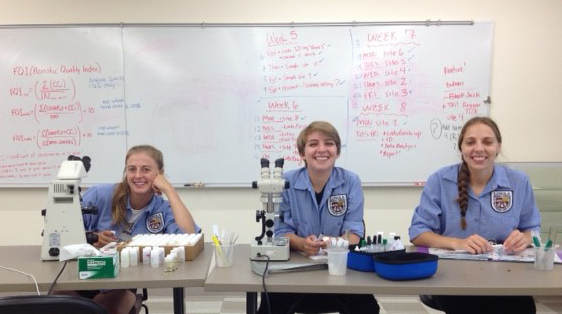Biodiversity Research
At LUREC, our Biodiversity Research Interns put their scientific knowledge into action by conducting various research projects. Take a look at their research below.
2017
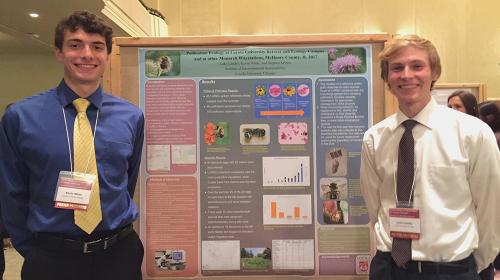
Pollination Ecology at Loyola University Retreat and Ecology Campus and at other Monarch Waystations, McHenry County, IL 2017
Luke Landry and Kevin White
Mentored by Stephen Mitten
Abstract:
A preliminary survey was conducted to identify floral visitors and their host flowers at Loyola University Retreat and Ecology Campus in McHenry County, Illinois over the summer of 2017. Pollen samples were gathered from 65 species of flowers and from 49 pollinators. Biological slide references of known pollen species were created for a database to compare with pollen samples collected from pollinators. The results allude to relationships between flowers and their insect pollinators. The Rusty Patched Bumble Bee (Bombus affinis) a newly enlisted endangered species, was documented for the first time. In addition, monarch butterfly (Danaus plexippus) information was gathered from five different monarch butterfly waystations dispersed throughout McHenry County. Data was collected on a weekly basis to obtain information on local monarch butterfly populations. Information gathered included monarch individuals per site with observed stages of monarch development. 83 monarch eggs and 25 caterpillars were documented. 30 combined eggs and caterpillars were raised in the lab and 25 adult monarchs were released outdoors. Fifteen other species of butterflies and moths were also observed at these waystations. The results revealed that LUREC had the highest number of monarch individuals while Dean Street and Triangle Prairie had the most Lepidoptera species observed. As the summer progressed, the number of monarchs observed increased. Pollination ecology is at its infancy and has great potential for assisting both specialist in ecosystem restorations and ecologist in determine the effects of climate change on pollination efficacy. Identifying the focal plants that would provide forage for the majority of pollinator taxa would be fruitful future research that could assist restoration specialists to select the main species of flora to plant.
Read the entire research paper here: Pollination Ecology Report
Landry and White were recipients of the STEM Outstanding Loyola Undergraduate Researcher Award for 2018. They were also the recipients of the Loyola University Community Engagement Award for Innovation in Sustainability. They received their awards at the 2018 Weekend of Excellence.
2016
The Aquatic Insect Community Structure and Accompanying Physiochemical Parameters of Powers Creek
Erica Becker, Lian Lucansky
Mentored by Stephen Mitten
Abstract:
A baseline biodiversity assessment of the aquatic insect community was conducted along with the physiochemical characteristics of Powers Creek at the Loyola University Chicago Retreat and Ecology Campus in McHenry County, Illinois over the summer of 2016. Powers Creek makes up 3.98 sq. mi. of the Boone-Dutch Creek Watershed, which is approximately 8.7% of the total watershed. The biotic and abiotic elements were examined at ten different sites along a 700m transect in order to understand the health of the creek itself and the dynamics of the aquatic insect community. One notable non-chemical abiotic factor was water temperature, which fluctuated over 9oC, from 15.5oC to 24.5oC. Insects were classified to family, and habitat features were recorded to understand the living conditions that the creek provides. The total aquatic insect count was 5,316 individuals represented by 65 families of which 58 of them were true aquatic representatives, the most prominent of which were Chironomidae, Elmidae, Simulidae, and Hydropsychidae. The results revealed a very significant difference in aquatic insect community structure paired with instream rock substrate. This research is a companion study to the research on the aquatic & shoreline terrestrial plant composition with floristic quality index of Powers Creek and contributes to the continuing biodiversity assessment of the entire property and is used to monitor ecosystem progression and change.
Read the entire research paper here: Aquatic Insect Community Structure
Aquatic & Shoreline Terrestrial Plant Composition with Floristic Quality Index of Powers Creek
Samantha Panock
Mentored by Stephen Mitten
Abstract:
Aquatic plant species and shoreline terrestrial plant species along the spring-fed Powers Creek at Loyola University Retreat and Ecology Campus (LUREC) were collected, identified, and analyzed to determine plant diversity using a percent coverage method. The purpose of this project was to conduct a baseline assessment of the plant species that inhabited the portion of Powers Creek that runs along the border of the LUREC property. Floristic quality index (nonnative and native) using coefficient of conservatism values was calculated for each site. A total of twenty five different plant species, including nineteen different families, were identified at ten sites along Powers Creek (Appendix A). Fifteen of the twenty five plant species (60%) were native to Illinois. The average total vegetation cover of the creek was 88.6%. The average FQI of all the sites was 13.639, and the average native FQI was 7.61. This research is a companion study to the research on aquatic insect community structure and the accompanying physiochemical parameters of Powers Creek. It contributes to the continuing biodiversity assessment of the entire property used to monitor ecosystem progression and change.
Read the entire research paper here: Aquatic & Shoreline Terrestrial Plant Composition
Becker, Lucansky and Panock were the 2017 recipients of the STEM Outstanding Loyola Undergraduate Researcher Award. They received their award at the Weekend of Excellence.
2015
Environmental Changes of Three Calcareous Ponds at Loyola Retreat and Ecology Campus
Graciela Olmedo, Reed Leopold, and Stephen Mitten
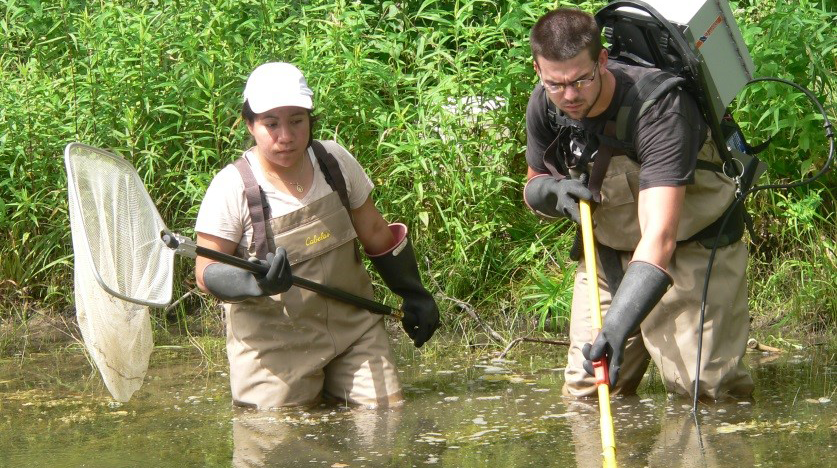
Abstract:
The human constructed retention ponds found on the northern side of the Loyola University Retreat and Ecology Campus (LUREC) property have developed their own role in campus ecosystem, creating an independent yet integrated part of the overall ecosystem and its health. We undertook a biodiversity survey of the three calcareous ponds. Our objectives in this project were to understand what organisms were present in each pond and then to determine the biotic and abiotic changes throughout the summer. Species richness and biodiversity indices of each pond throughout the summer were calculated. A total number of 148,229 individuals of 246 species were recorded.
Examine the poster presentation: Environmental changes in three Calcareous Ponds.
In addition, Graciela georeferenced every milkweed plant on the campus for the Friends of Hackmatack US Fish and Wildlife refuges’ “Monarchs & McHenry Project “.
Graciela Olmedo was awarded the E. O. Wilson Award for Outstanding Performance in Independent Research in 2016. This award recognizes the outstanding performance of one IES graduating senior in faculty-mentored research.
2014
Ecosystem Profile Assessment of Biodiversity at Loyola University Retreat and Ecology Campus
Catherine Pacholski, Samantha Keyport, Joseph Gasior and Stephen Mitten
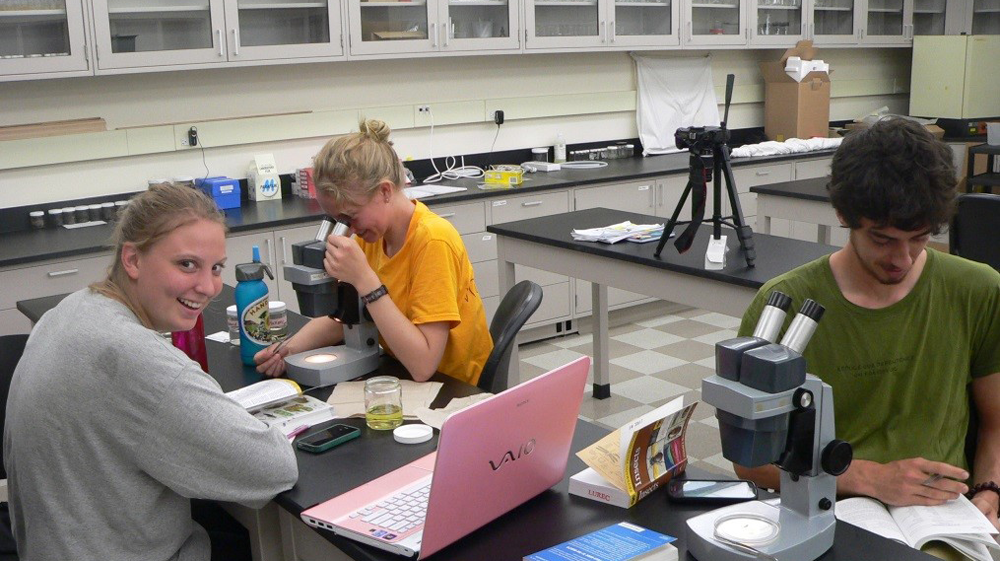
Abstract:
An ecosystem profile assessment of biodiversity for four plots representing four distinct terrestrial ecotypes and three small calcareous ponds within the 98-acre property of Loyola’s University Retreat and Ecology Campus (LUREC) were performed during June–mid-August of 2014. Read the entire Ecosystem Profile Assessment of Biodiversity at LUREC.
Pacholski and Keyport were the 2015 recipients of the STEM Outstanding Loyola Undergraduate Researcher Award. They received their award at this year's Weekend of Excellence.
2013
Biodiversity Research at LUREC
In 2013, Biodiversity Intern Edgar Perez wrote a comprehensive report on a number of activities he was responsible for at LUREC. Perez took GPS coordinates of one thousand five hundred and twenty-two trees (1,522) of the more than four thousand one-hundred and fifty-six (4,156) trees documented on campus, monitored bird nests, and documented the expansion of the thirteen-lined ground squirrels across the front of the LUREC campus among other projects during the summer.
His final report is available here: 2013 Biodiversity Research at LUREC Final Report. View his powerpoint presentation here: Biodiversity Research at LUREC. In April 2014, Edgar Perez received the Most Outstanding Undergraduate Researcher Award for his two years of combined work at LUREC.
2012
Avian Species Structure at Loyola University Retreat and Ecology Campus During the 2012 Summer Breeding Season
Edgar R. Perez and Stephen Mitten
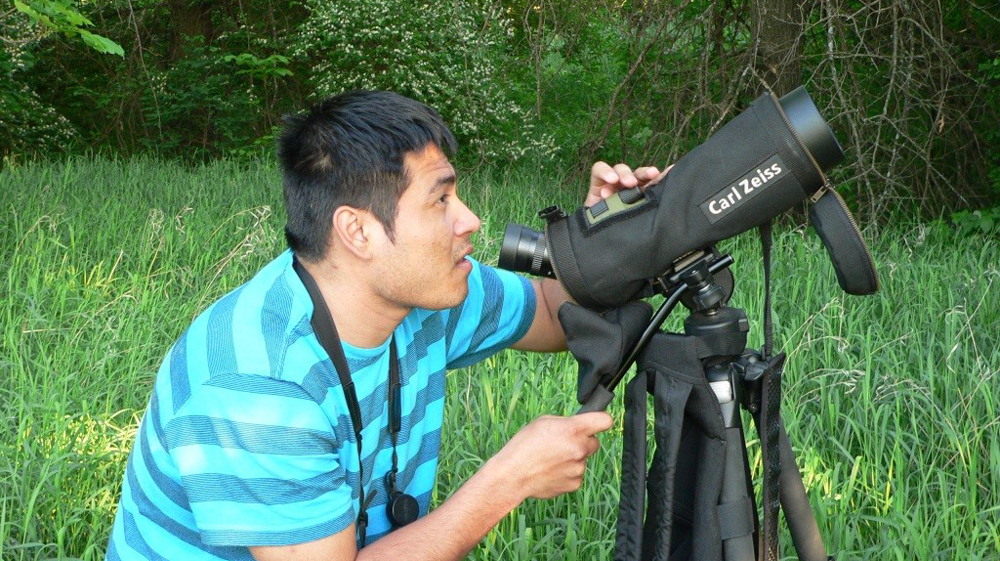
Abstract:
We undertook a breeding census of the avian community residing on the 98 acre (39.7 hectare) property of Loyola University Retreat and Ecology Campus (LUREC) over a two month period (May 12–July 18) in the summer of 2012. Territory-spot mapping was the primary method used, supplemented by timed counts, opportunistic visual sightings and nest searches. Sixty-nine species were documented: forty species were found breeding or holding territories on the campus with an additional twenty-nine species detected as flyovers or occasional visitors. Read the entire 2012 Avian Species Structure Final Report.
At LUREC, our Biodiversity Research Interns put their scientific knowledge into action by conducting various research projects. Take a look at their research below.
2017

Pollination Ecology at Loyola University Retreat and Ecology Campus and at other Monarch Waystations, McHenry County, IL 2017
Luke Landry and Kevin White
Mentored by Stephen Mitten
Abstract:
A preliminary survey was conducted to identify floral visitors and their host flowers at Loyola University Retreat and Ecology Campus in McHenry County, Illinois over the summer of 2017. Pollen samples were gathered from 65 species of flowers and from 49 pollinators. Biological slide references of known pollen species were created for a database to compare with pollen samples collected from pollinators. The results allude to relationships between flowers and their insect pollinators. The Rusty Patched Bumble Bee (Bombus affinis) a newly enlisted endangered species, was documented for the first time. In addition, monarch butterfly (Danaus plexippus) information was gathered from five different monarch butterfly waystations dispersed throughout McHenry County. Data was collected on a weekly basis to obtain information on local monarch butterfly populations. Information gathered included monarch individuals per site with observed stages of monarch development. 83 monarch eggs and 25 caterpillars were documented. 30 combined eggs and caterpillars were raised in the lab and 25 adult monarchs were released outdoors. Fifteen other species of butterflies and moths were also observed at these waystations. The results revealed that LUREC had the highest number of monarch individuals while Dean Street and Triangle Prairie had the most Lepidoptera species observed. As the summer progressed, the number of monarchs observed increased. Pollination ecology is at its infancy and has great potential for assisting both specialist in ecosystem restorations and ecologist in determine the effects of climate change on pollination efficacy. Identifying the focal plants that would provide forage for the majority of pollinator taxa would be fruitful future research that could assist restoration specialists to select the main species of flora to plant.
Read the entire research paper here: Pollination Ecology Report
Landry and White were recipients of the STEM Outstanding Loyola Undergraduate Researcher Award for 2018. They were also the recipients of the Loyola University Community Engagement Award for Innovation in Sustainability. They received their awards at the 2018 Weekend of Excellence.
2016
The Aquatic Insect Community Structure and Accompanying Physiochemical Parameters of Powers Creek
Erica Becker, Lian Lucansky
Mentored by Stephen Mitten
Abstract:
A baseline biodiversity assessment of the aquatic insect community was conducted along with the physiochemical characteristics of Powers Creek at the Loyola University Chicago Retreat and Ecology Campus in McHenry County, Illinois over the summer of 2016. Powers Creek makes up 3.98 sq. mi. of the Boone-Dutch Creek Watershed, which is approximately 8.7% of the total watershed. The biotic and abiotic elements were examined at ten different sites along a 700m transect in order to understand the health of the creek itself and the dynamics of the aquatic insect community. One notable non-chemical abiotic factor was water temperature, which fluctuated over 9oC, from 15.5oC to 24.5oC. Insects were classified to family, and habitat features were recorded to understand the living conditions that the creek provides. The total aquatic insect count was 5,316 individuals represented by 65 families of which 58 of them were true aquatic representatives, the most prominent of which were Chironomidae, Elmidae, Simulidae, and Hydropsychidae. The results revealed a very significant difference in aquatic insect community structure paired with instream rock substrate. This research is a companion study to the research on the aquatic & shoreline terrestrial plant composition with floristic quality index of Powers Creek and contributes to the continuing biodiversity assessment of the entire property and is used to monitor ecosystem progression and change.
Read the entire research paper here: Aquatic Insect Community Structure
Aquatic & Shoreline Terrestrial Plant Composition with Floristic Quality Index of Powers Creek
Samantha Panock
Mentored by Stephen Mitten
Abstract:
Aquatic plant species and shoreline terrestrial plant species along the spring-fed Powers Creek at Loyola University Retreat and Ecology Campus (LUREC) were collected, identified, and analyzed to determine plant diversity using a percent coverage method. The purpose of this project was to conduct a baseline assessment of the plant species that inhabited the portion of Powers Creek that runs along the border of the LUREC property. Floristic quality index (nonnative and native) using coefficient of conservatism values was calculated for each site. A total of twenty five different plant species, including nineteen different families, were identified at ten sites along Powers Creek (Appendix A). Fifteen of the twenty five plant species (60%) were native to Illinois. The average total vegetation cover of the creek was 88.6%. The average FQI of all the sites was 13.639, and the average native FQI was 7.61. This research is a companion study to the research on aquatic insect community structure and the accompanying physiochemical parameters of Powers Creek. It contributes to the continuing biodiversity assessment of the entire property used to monitor ecosystem progression and change.
Read the entire research paper here: Aquatic & Shoreline Terrestrial Plant Composition
Becker, Lucansky and Panock were the 2017 recipients of the STEM Outstanding Loyola Undergraduate Researcher Award. They received their award at the Weekend of Excellence.
2015
Environmental Changes of Three Calcareous Ponds at Loyola Retreat and Ecology Campus
Graciela Olmedo, Reed Leopold, and Stephen Mitten

Abstract:
The human constructed retention ponds found on the northern side of the Loyola University Retreat and Ecology Campus (LUREC) property have developed their own role in campus ecosystem, creating an independent yet integrated part of the overall ecosystem and its health. We undertook a biodiversity survey of the three calcareous ponds. Our objectives in this project were to understand what organisms were present in each pond and then to determine the biotic and abiotic changes throughout the summer. Species richness and biodiversity indices of each pond throughout the summer were calculated. A total number of 148,229 individuals of 246 species were recorded.
Examine the poster presentation: Environmental changes in three Calcareous Ponds.
In addition, Graciela georeferenced every milkweed plant on the campus for the Friends of Hackmatack US Fish and Wildlife refuges’ “Monarchs & McHenry Project “.
Graciela Olmedo was awarded the E. O. Wilson Award for Outstanding Performance in Independent Research in 2016. This award recognizes the outstanding performance of one IES graduating senior in faculty-mentored research.
2014
Ecosystem Profile Assessment of Biodiversity at Loyola University Retreat and Ecology Campus
Catherine Pacholski, Samantha Keyport, Joseph Gasior and Stephen Mitten

Abstract:
An ecosystem profile assessment of biodiversity for four plots representing four distinct terrestrial ecotypes and three small calcareous ponds within the 98-acre property of Loyola’s University Retreat and Ecology Campus (LUREC) were performed during June–mid-August of 2014. Read the entire Ecosystem Profile Assessment of Biodiversity at LUREC.
Pacholski and Keyport were the 2015 recipients of the STEM Outstanding Loyola Undergraduate Researcher Award. They received their award at this year's Weekend of Excellence.
2013
Biodiversity Research at LUREC
In 2013, Biodiversity Intern Edgar Perez wrote a comprehensive report on a number of activities he was responsible for at LUREC. Perez took GPS coordinates of one thousand five hundred and twenty-two trees (1,522) of the more than four thousand one-hundred and fifty-six (4,156) trees documented on campus, monitored bird nests, and documented the expansion of the thirteen-lined ground squirrels across the front of the LUREC campus among other projects during the summer.
His final report is available here: 2013 Biodiversity Research at LUREC Final Report. View his powerpoint presentation here: Biodiversity Research at LUREC. In April 2014, Edgar Perez received the Most Outstanding Undergraduate Researcher Award for his two years of combined work at LUREC.
2012
Avian Species Structure at Loyola University Retreat and Ecology Campus During the 2012 Summer Breeding Season
Edgar R. Perez and Stephen Mitten

Abstract:
We undertook a breeding census of the avian community residing on the 98 acre (39.7 hectare) property of Loyola University Retreat and Ecology Campus (LUREC) over a two month period (May 12–July 18) in the summer of 2012. Territory-spot mapping was the primary method used, supplemented by timed counts, opportunistic visual sightings and nest searches. Sixty-nine species were documented: forty species were found breeding or holding territories on the campus with an additional twenty-nine species detected as flyovers or occasional visitors. Read the entire 2012 Avian Species Structure Final Report.

